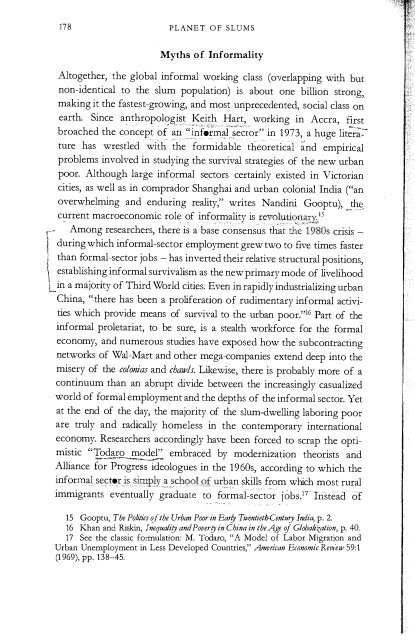Untitled - Rebel Studies Library
Untitled - Rebel Studies Library
Untitled - Rebel Studies Library
Create successful ePaper yourself
Turn your PDF publications into a flip-book with our unique Google optimized e-Paper software.
178 PLANET OF SLUMS<br />
Myths of Informality<br />
Altogether, the global informal working class (overlapping with but<br />
non-identical to the slum population) is about one billion strong,<br />
making it the fastest-growing, and most unprecedented, social class on<br />
earth. Since anthropologist , Keith Hart" working in Accra, first<br />
broached the cncept elf" ; ' ;iflf;aCs'"tor" in 1973, a huge litr':<br />
ture has wrestled 'with the formidable theoretical nd empirical<br />
problems involved in studying the survival strategies of the new urban<br />
poor. Although large informal sectors certainly existed in Victorian<br />
cities, as well as in comprador Shanghai and urban colonial India ("an<br />
overwhelming and enduring reality," writes Nandini Gooptu), _t.<br />
current macroeconomic role of informality is revolution'W,$1 5<br />
! . Among researchers, there i a base cnsensus !:hat th " 1980s crisis <br />
during which informal-sector employment grew two to five times faster<br />
than formal-sector jobs - has inverted their relative structural positions,<br />
\ establishing informal survivalism as the new primary mode of livelihood<br />
L in a majority of Third World cities. Even in rapidly industrializing urban<br />
China, "there has been a proliferation of rudimentary informal activi-<br />
ties which provide means of survival to the urban poor."16 Part of the<br />
informal proletariat, to be sure, is a stealth workforce for the formal<br />
economy, and numerous studies have exposed how the subcontracting<br />
networks of Wal-Mart and other mega-companies extend deep into the<br />
misery of the colonias and chawls. Likewise, there is probably more of a<br />
continuum than an abrupt divide between the increasingly casualized<br />
world of formal employment and the depths of the informal sector. Yet<br />
at the end of the day, the majority of the slum-dwelling laboring poor<br />
are truly and radically homeless in the contemporary international<br />
economy. Researchers accordingly have been forced to scrap the optimistic<br />
"Todaro model" embraced by modernization theorists and<br />
Alliance fo' ; - p;;g;;idologues in the 1960s, according to which the<br />
informal sectr is simply a school oJ uran skills from which most rural<br />
immigrants eventually g ' raduate to f () rmai-sectr jobS.IT Instead of<br />
15 Gooptu, The Politics f the Urban Poor in Early Twentieth-Century India, p. 2.<br />
16 Khan and Riskin, Inequality and Poverty in China in the Age f Globalzzatzon, p. 40.<br />
17 See the classic formulation: M. Todaro, "A Model of Labor MIgration and<br />
Urban Unemployment in Less Developed Countries," Amelican Economic Ret'iew 59:1<br />
(1 969), pp. 138-45.<br />
A SURPLUS HUMANITY? 179<br />
upward mobility, there is seemingly only a down staircase by which<br />
redundant formal-sector workers and sacked public employees descend<br />
into the black economy.<br />
Yet there has been much resistance to drawing the straightforward<br />
conclusion that the growth of informality is an explosion of "active"<br />
unemployment, what the ILO's Oberai characterizes as the "substitution<br />
of underemployment and disguised unemployed for increases in<br />
open unemployment."IB Apostles of self-help and NGO-scale<br />
programs indeed blanch when veteran researchers such as Jan Breman<br />
(who has spent 40 years studying poverty in India and Indonesia)<br />
conclude that up::Y!l:Lci_gl9bjJit¥ j!lJh. inf()r@al sqg()rn,yis largely , a<br />
"myth inspir r.i§E . !l.g'I9 Instead, innumerable studies -<br />
oft-SpO'nsred by the World Bank and other pillars of the so-called<br />
Washington Consensus - have sought consolation in the belief that the<br />
informal sector is potentially the urban Third World's deus ex machina.<br />
Hernando de Soto, of course, is internationally famous for arguing<br />
that this enormous population of marginalized laborers and expeasants<br />
is a frenzied beehive of proto-capitalists yearning for formal<br />
property rights and unregulated competitive space: "Marx would<br />
probably be shocked to find how in developing countries much of the<br />
teeming mass does not consist of oppressed legal proletarians but of<br />
oppressed extralegal small entrepreneurs." 20 De Soto's bootstrap model of<br />
development, as we have seen, is especially popular because of the simplicity<br />
of his recipe: get the state (and formal-sector labor unions) out<br />
of the way, add micro-credit for micro-entrepreneurs and land titling<br />
for squatters, then let markets take their course to produce the transubstantiation<br />
of poverty into capitaL (De Soto-inspired optimism, in<br />
its most absurd version, has led some development-aid bureaucrats<br />
to redefine slums as "Strategic Low-Income Urban Management<br />
Systems."?1 This semi-utopian view of the informal sector, however,<br />
grows out of a nested set of epistemological fallacies.<br />
18 Oberai, Population Growth, Employment andPovertyin Third-U;orldMegcrCities, p. 64.<br />
, '1 9 '!Jan Breman, The Labouring Poor: Patterns f Exploztaflon, 5 ubordznaflon, and<br />
Exclusion, New Delhi, p. 174.<br />
20 Quoted in Donald Krueckeberg, "The Lessons of John Locke or Hernando<br />
de Soto: What if Your Dreams Come True?," Housing Policy Debate 15:1 (2004), p. 2 :<br />
21 Michael Mutter, UK Department for International Development, quoted In<br />
Environment and Urbanization 15:1 (April 2003), p. 12.


